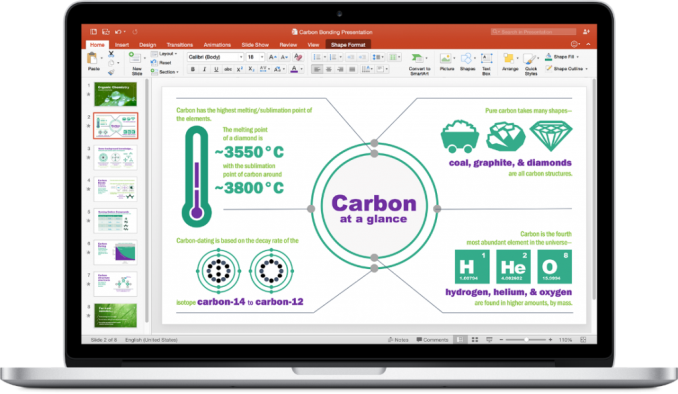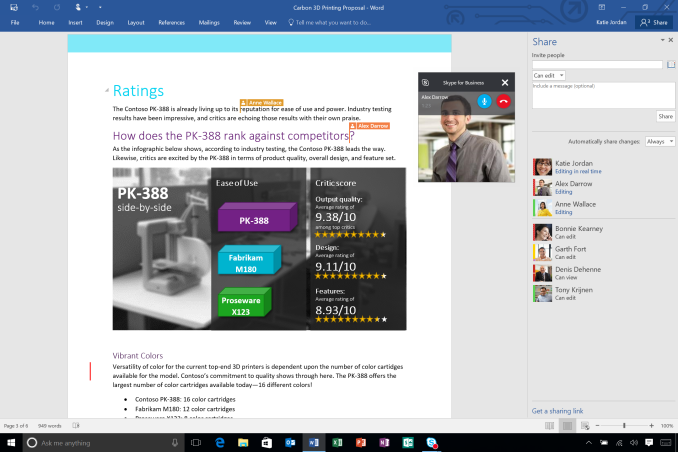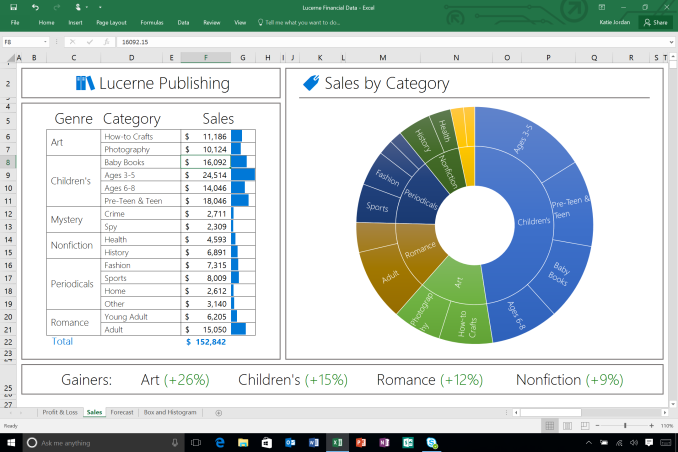Microsoft Office 2016 Is Released Worldwide Today
by Brett Howse on September 22, 2015 7:15 PM EST- Posted in
- Software
- Microsoft
- Office
- Office 2016

Today Microsoft is launching a pretty important set of products. Office 2016 is now available worldwide, and marks the first major update to the suite since Office 2013 was released in January of 2013. While many people think Microsoft and Windows are synonymous, Office has consistently been a bigger chunk of their revenues for quite some time, so any time there is an update to this suite it is a pretty big deal for the company. Microsoft is pushing this strongly now through their Office 365 subscription model, whether for home or commercial use, but the one-time purchase model is still around for those that prefer to buy it outright. The Mac version of Office 2016 was released earlier this year, but just for Office 365 customers. That suite is now also able to be purchased standalone as of today.
Every time a new Office suite is released, I always wonder what else they need to add to Office, but time and time again there always seems to be something that improves my workflow. The 2016 version finally gains a pretty nice new feature, which is real-time collaboration. This has long been a staple of Google Docs and even Microsoft has offered it in the web based version of Office since 2013, but it has been absent from the desktop version. This is a much requested feature and it will be used quite a bit I think. Co-authoring will first be available in Word, and will be coming to the other applications in the future.
Not too long ago, Microsoft rebranded their Lync client to Skype for Business, and this is now integrated right into the Office suite as well. This will allow you to chat right inside of Word, possibly as you are co-authoring a document with someone. It also allows screen sharing and the ability to launch a meeting from right within the Office apps.
Also new are Office 365 Groups, which is part of Outlook 2016 and also available on iOS, Android, and Windows Phone. Groups allows you to create shared inboxes and calendars along with dedicated cloud storage for the group in order to assist with collaboration.
People subscribed to Office 365 Business will be glad to hear that Microsoft will be updating the OneDrive for Business sync client later this month, which will FINALLY offer selective sync for Windows and Mac, and they are claiming there is improved reliability as well but that will be something that I think users of OneDrive for Business will want to see for themselves.
On the business side, Office 2016 will be gaining a lot of enterprise features to help protect data including built-in Data Loss Prevention which will “significantly reduce the risk of leaking sensitive data by giving IT admins tools to centrally create, manage and enforce policies for content authoring and document sharing” and later this year Windows 10 will enable Enterprise Data Protection. This prevents sharing of data outside the company that is deemed to be restricted.
 Office 2016 for Mac finally looks and feels like the PC version
Office 2016 for Mac finally looks and feels like the PC version
Overall, there are a lot of changes to Office 2016. Likely more than you would think considering Office has been around for so long, and is certainly a mature toolset. But the addition of real-time co-authoring brings one of the nicest features of web based suites to the desktop client. Going forward, Office on Windows will have its update cadence increased to more closely match what they are doing with the mobile and web apps. This should mean new features and updates come a long much quicker.
For those that want to upgrade, Office 365 Home users can do that here, Office 365 Business can do it here, and for more information please check out office.com/2016
Source: Office Blog












35 Comments
View All Comments
eisa01 - Wednesday, September 23, 2015 - link
I'm pretty sure it's still alt-h-v-v in 2010 and 2013. alt-e-s-v still worksI would say for most the ribbon interface is better for keyboard shortcuts, as they're discoverable by pressing the alt key. But I was not a heavy Excel user in the 2003 era
dullard - Wednesday, September 23, 2015 - link
Extide, did you think at ALL when saying the ribbon is less clicks for Excel? One of the most useful and most basic thing of all to do in Excel is to create a graph. Before Excel 2003, you highlighted the data to graph, click the graph button, and then click on the graph to start updating it as needed. Basically 3 clicks and you have a basic graph before the ribbon.With the ribbon it is a MINIMUM of 13 clicks:
1) Highlight data,
2) Click Insert,
3) Click Scatter (assuming you are doing anything scientific, if not you can click other graph types),
4) Click the correct form of the graph,
5) Click Layout,
6) Click Chart Title,
7) Click the title's location,
8) Click Axis Titles,
9) Click Primary Horizontal Axis Title,
10) Click Title Below Axis (because why would you choose the default no horizontal tile just after steps 8 and 9)
11) Click Axis Titles,
12) Click Primary Vertical Axis Title,
13) Click a vertical type (because why would you choose the default no vertical tile just after steps 11 and 12)
dullard - Wednesday, September 23, 2015 - link
Opps, that should have been TITLE, not TILE in my post above.And don't get me started on why the default ribbon has the Insert commands (like Insert rows and columns on the Home ribbon tab, and not the Insert ribbon tab). Or other added button presses (like when you have a narrow Excel window, all buttons like the cell color button require one more button press than when you have a wide Excel window - try it).
Wolfpup - Wednesday, September 23, 2015 - link
What's weird is I actually like the ribbon in Windows 8's Explorer interface. Like there's more options, and they look better/are orgainized better than in 7...yet I've still not really adjusted to Office's Ribbon. I mean I'm used to it now, but...Anyway I'm semi-tempted to buy 2016, even though I don't think it really does anything new I need. I could do with some note features for Word, a split panel WYSIWYG HTML editor for Word, but baring that...
There for a while I was doing OpenOffice (I guess LibreOffice is still better supported?) but I don't know, I'm back on MS Office for now.
Paul Klier - Wednesday, September 23, 2015 - link
Try out SoftMaker Office 2016. If you don't know it yet: it's an excellent office suite made in Germany that uses the good old menus as in MS Office 2003 but with several modern extensions. TextMaker (word processor), PlanMaker (spreadsheet) and Presentations (presentation software) open and save all lkind of Microsoft Office formats generally without flaws, and the schope of features is impressing - on the same level as Microsoft Office and under several aspects even beyond. Price is reasonable, about $80 for three licenses (compare that with Microsoft Office 2016). SoftMaker offers free technical supportm, and t5hey release regular updates with improvements and new features. I can strongly recommend it.joex4444 - Wednesday, September 23, 2015 - link
12 year old software is best software, am I right?Murloc - Wednesday, September 23, 2015 - link
ribbon was the single thing that changed my experience the most. It's much faster to use, and you don't have to look for stuff through menus and activate buttons, it comes up with the right context.marvdmartian - Wednesday, September 23, 2015 - link
Actually, just installed Office 2013 on my home machine, and I'm still having to use 2010 at work. Not sure if anyone else noticed a similar effect, but it seems that 2013 is actually slower at opening than 2010? Boy, there's a productivity increase, eh?[from the article] "Overall, there are a lot of changes to Office 2016. Likely more than you would think considering Office has been around for so long, and is certainly a mature toolset. "
This is because software engineers feel the compulsion to constantly "improve" on their product. Even if there's nothing wrong with it. Even if it doesn't actually improve said product. Even if, as I have noticed, it slows down the product!
WHY?? The only reason I can come up with is that it helps them prove that their jobs are necessary, because they're "improving" the product, which will bring more sales of the product. So long as the profit made off of those sales exceeds the cost of keeping the software monkeys, the bean counters will go along with it.
SteelRing - Wednesday, September 23, 2015 - link
True dat... Office2003 was the only release that ever mattered. Everything since then is only trying to guess what could be improved but really there is nothing that you couldn't do before. A nicer look maybe, a controversial ribbon, etc.... just more money for them and more work for you to re-learn how to do the same sh1t all over again.Makaveli - Saturday, September 26, 2015 - link
Office 2013 loading slower than Office 2010 is the reverse of what I saw then I just recently upgraded to 2013. I think there is an issue with your setup.